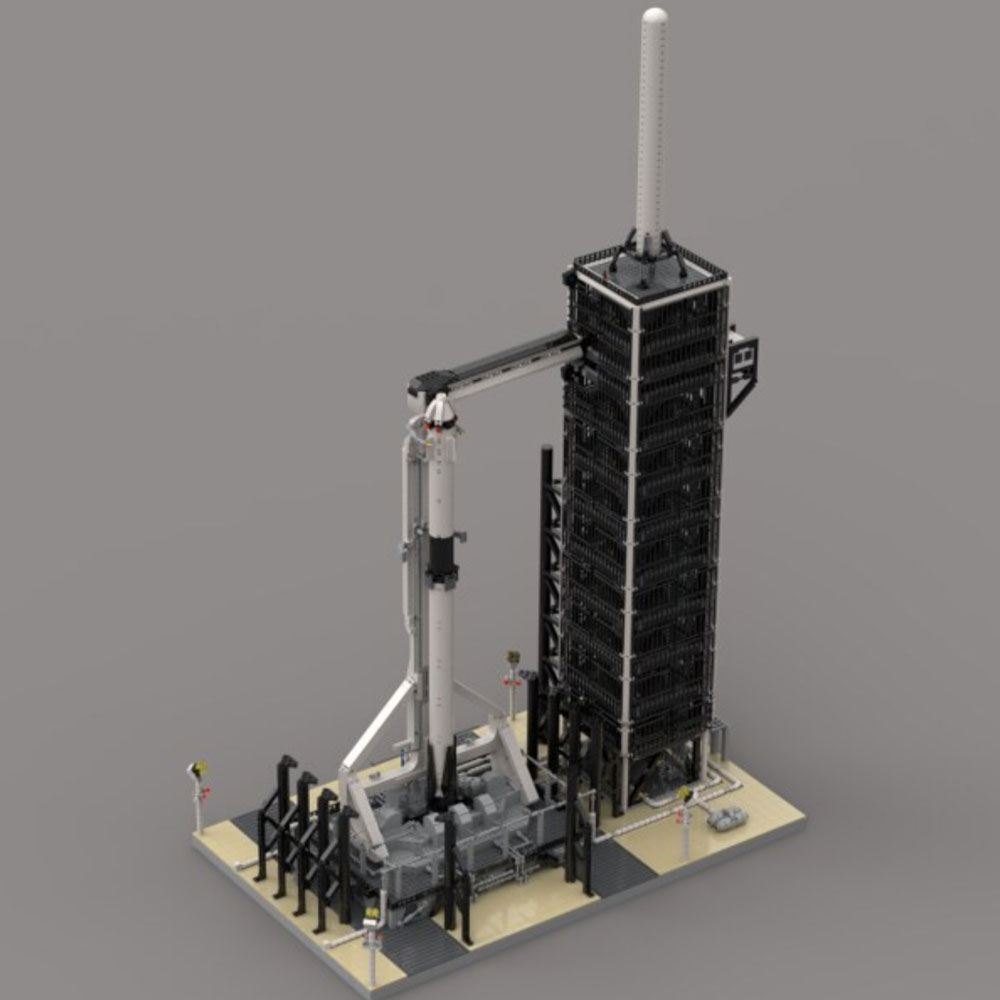
LEGO Designer:
Sam Bradford (0 Gravity Bricks)
Designed:
April 2019
Categories:
Launch Pads, All
Launch Vehicle Details
Stages:
Length:
Diameter:
Mass at Launch:
Low Earth Orbit Capacity:
Total Thrust:
Apogee:
Class:
On April 14, 2014, the privately owned launch service provider SpaceX signed a 20-year lease for Launch Complex 39a (LC-39A). The pad was modified to support launches of both Falcon 9 and Falcon Heavy launch vehicles, modifications that included the construction of a large Horizontal Integration Facility (HIF) similar to that used at existing SpaceX-leased facilities at Cape Canaveral Air Force Station and Vandenberg Air Force Base, horizontal integration being markedly difference from the vertical integration process used to assemble NASA’s Apollo and Space Shuttle vehicles at the launch complex. Additionally, new instrumentation and control systems were installed, and substantial new plumbing was added for a variety of rocket liquids and gases.
SpaceX utilises the former Fixed Service Structure (FSS) of the Launch Complex 39a launch towers and intends to extend it above its former 350-foot (110 m) height. It did not need the Rotating Service Structure (RSS) and removed it beginning in February 2016. NASA removed the Orbiter Servicing Arm—with intent to use the space later to build a museum—and the white room by which astronauts entered the Space Shuttle. SpaceX plans to add at least two additional levels to the FSS, to provide crew access for the Dragon 2 launches.
SpaceX assembles its launch vehicles horizontally in a hangar near the pad, and transports them horizontally to the pad before erecting the vehicle to vertical for the launch. For military missions from Pad 39A, payloads will be vertically integrated, as that is required per launch contract with the US Air Force. A hammerhead crane is planned to be added to the FSS in order to support US military requirements for vertical payload integration.
Pad 39A will be used to host launches of astronauts on the crewed-version of the Dragon space capsule in a public–private partnership with NASA. SpaceX intends to add “a crew gantry access arm and white room to allow for crew and cargo ingress to the vehicle. The existing Space Shuttle evacuation slide-wire basket system will also be re-purposed to provide a safe emergency egress for the Dragon crew in the event of an emergency on the pad that does not necessitate using the Crew Dragon’s launch abort system.”
In August 2018, SpaceX’s Crew Access Arm (CAA) was installed on a new level, which was built at the necessary height to enter the Crew Dragon spacecraft atop a Falcon 9 rocket. In September 2018, the refurbished Space Shuttle Emergency Egress System was raised to this new level.
The first SpaceX launch from pad Launch Complex 39a was SpaceX CRS-10 on February 19, 2017, using a Falcon 9 launch vehicle; it was the company’s 10th cargo resupply mission to the International Space Station, and the first uncrewed launch from 39A since Skylab.
On February 6, 2018, Launch Complex 39a hosted the successful liftoff of the Falcon Heavy on its maiden launch, carrying Elon Musk’s Tesla Roadster car to space; and the first flight of the human-rated spacecraft Crew Dragon (Dragon 2) took place there on March 2, 2019.
The second Falcon Heavy flight, carrying the Arabsat-6A communications satellite for Arabsat of Saudi Arabia, successfully launched on April 11, 2019. The satellite is to provide Ku band and Ka band communication services for the Middle East and northern Africa, as well as for South Africa. The launch was notable as it marked the first time that SpaceX was able to successfully soft-land all three of the reusable booster stages, which will be refurbished for future launches.
Designer Notes
| Unit | width | length | height |
|---|---|---|---|
| Studs | 55.9 | 89.3 | 142 |
| Centimetres | 44.7 | 71.4 | 113.6 |
| Inches | 17.6 | 28.1 | 44.7 |
Downloads
This model will have an updated version soon. Currently undergoing redesign.
This model will have an updated version soon. Currently undergoing redesign.
Part count: 9283 bricks, 468 lots.
| Unit | width | length | height |
|---|---|---|---|
| Studs | 55.9 | 89.3 | 142.0 |
| Inches | 17.6 | 28.1 | 44.7 |
| Centimetres | 44.7 | 71.4 | 113.6 |
No external URL provided.
Launch History information from space.skyrocket.de
Launch History information from space.skyrocket.de
Related Posts
None found

